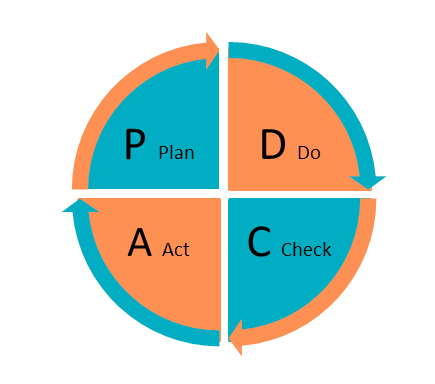Target group
The Quality Indicators’ target group are all the relevant stakeholders in VET provision in the field of ADHD at National and European level, addressing mainly VET providers (both iVET and cVET), as well as associations, ADHD learners’ parents, policy makers, and enterprises and any other stakeholders having responsibilities in ADHD.
Structure
The whole Indicators’ system is composed by 14 indicators and it is structured in the following four sections, with the relative sub-sections:
- Policy/Strategy of the Institution/VET Provider
- Learning Contents
- Training Delivery
- Organization.
To each indicator has been assigned one or more of the correspective EQAVET and PDCA indicator/s.
QA Indicators for VET for ADHD learners
The list of Quality Indicators with the correspondent EQAVET and PDCA indicator/s divided into sections and subsections is given below.
| Sections | Indicators | EQAVET | PDCA | |
|---|---|---|---|---|
| 1. Policy/ Strategy | ||||
| a. Vision | 1.1. | Its vision includes its clear engagement to support the inclusive education | 8, 10 | P |
| b. Mission | 1.2. | Its mission sets learners with special education needs (SEN) as one of the target groups of its training services | 8 | P |
| c. Networking | 1.3. | Develops partnerships with associations/organisations representing learners with SEN, parents, researchers aiming at providing an inclusive training | 2 | D |
| d. Updating | 1.4. | Encourages staff to get extra qualification in order to be aware of the current situation and the policy of inclusive education for SEN learners | 2 | D |
| 2. Learning content | ||||
| a. Learning methods | 2.1. | The proposed learning methods are designed in line with the specific requirements for learners with SEN* | 1,2 | D |
| 2.1.a | Level of adaptation and reduction of learning content according to learning difficulties | 2 | D | |
| 2.1.b | Type of additional support for personal development | 2 | D | |
| 3. Training delivery | ||||
| a. Learning material | 3.1. | The learning materials are developed in cooperation with experts in the field of inclusive education for learners with SEN | 2, 6 | C |
| b. Customized assessment | 3.2. | It assures the possibility for learners with SEN to be evaluated through customized assessment procedure and instruments (customized both in quantity and quality) | 2, 6 | C |
| c. Learning environment | 3.3. | Specific conditions* for learners with SEN are made available in the learning environments (e.g. classes, online) | 2, 6 | D |
| d. Individual needs | 3.4. | There are the necessary learning adaptations and modifications made according to the individual needs of SEN students | 2, 6 | C |
| e. Support | 3.5. | There are the necessary adaptations and modifications made to create a supportive learning environment for SEN students | 2, 6 | C |
| 4. Organization | ||||
| a. Staff development | 4.1. | The teaching staff is trained on the needs of learners with SEN and on the adjustments needed for teaching strategies and materials | 2, 6 | D |
| b. Staff allocation | 4.2. | There is staff equipped with specific competencies offering customized educational and non educational services to learners with SEN (e.g. dedicated offices) | 6 | D |
| c. Placement facilitation | 4.3. | It provides to in-company tutors/mentors specific guidelines/training for hosting learners with SEN during the internships/stages | 6 | A |
| d. Monitoring instruments | 4.4. | It ensures the continuous monitoring of learners with SEN for assessing: the quality of educational and non educational services, the accessibility of training, the success rate and the employability opportunities | 6, 8 | A |
EQAVET Indicators
You can learn more about the EQAVET Indicators here: http://www.eqavet.eu
Deming Cycle
PDCA (Plan–Do–Check–Act or Plan–Do–Check–Adjust) is an iterative four-step management method used in business for the control and continual improvement of processes and products. It is also known as the Deming circle/cycle/wheel, the Shewhart cycle, the control circle/cycle, or plan–do–study–act (PDSA).
You can learn more here.

